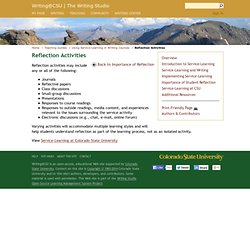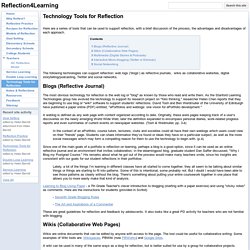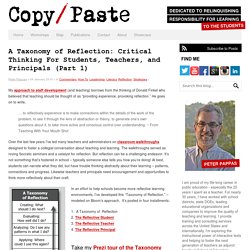

Reflection Activities. Reflection activities may include any or all of the following: JournalsReflective papersClass discussionsSmall-group discussionsPresentationsResponses to course readingsResponses to outside readings, media content, and experiences relevant to the issues surrounding the service activityElectronic discussions (e.g., chat, e-mail, online forum) Varying activities will accommodate multiple learning styles and will help students understand reflection as part of the learning process, not as an isolated activity.

View Service-Learning at Colorado State University. Technology Tools for Reflection - Reflection for Learning. Here are a series of tools that can be used to support reflection, with a brief discussion of the process, the advantages and disadvantages of each approach.

The following technologies can support reflection: web logs (‘blogs’) as reflective journals, wikis as collaborative websites, digital storytelling/podcasting, Twitter and social networks. Blogs (Reflective Journal) A Taxonomy of Reflection: A Model for Critical Thinking. My approach to staff development (and teaching) borrows from the thinking of Donald Finkel who believed that teaching should be thought of as “providing experience, provoking reflection.”

He goes on to write, … to reflectively experience is to make connections within the details of the work of the problem, to see it through the lens of abstraction or theory, to generate one’s own questions about it, to take more active and conscious control over understanding. ~ From Teaching With Your Mouth Shut Over the last few years I’ve led many teachers and administrators on classroom walkthroughs designed to foster a collegial conversation about teaching and learning.